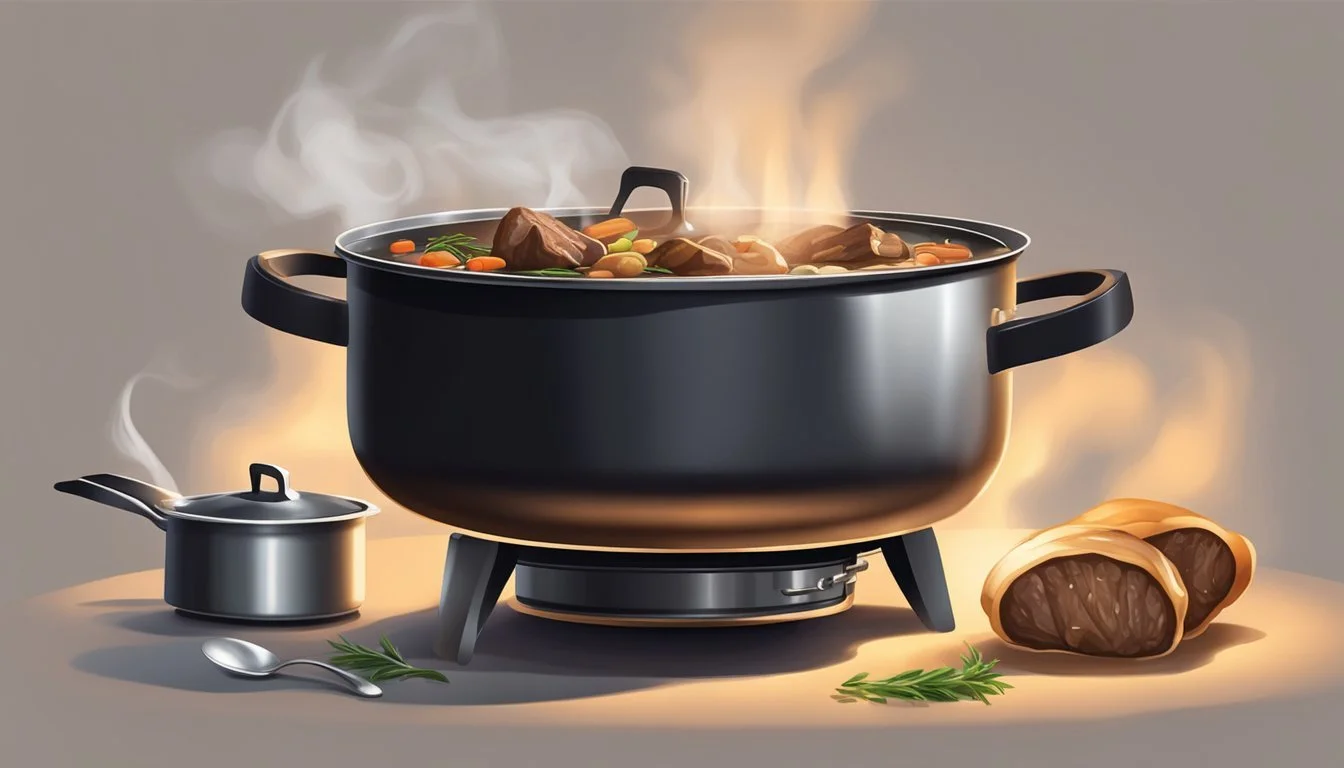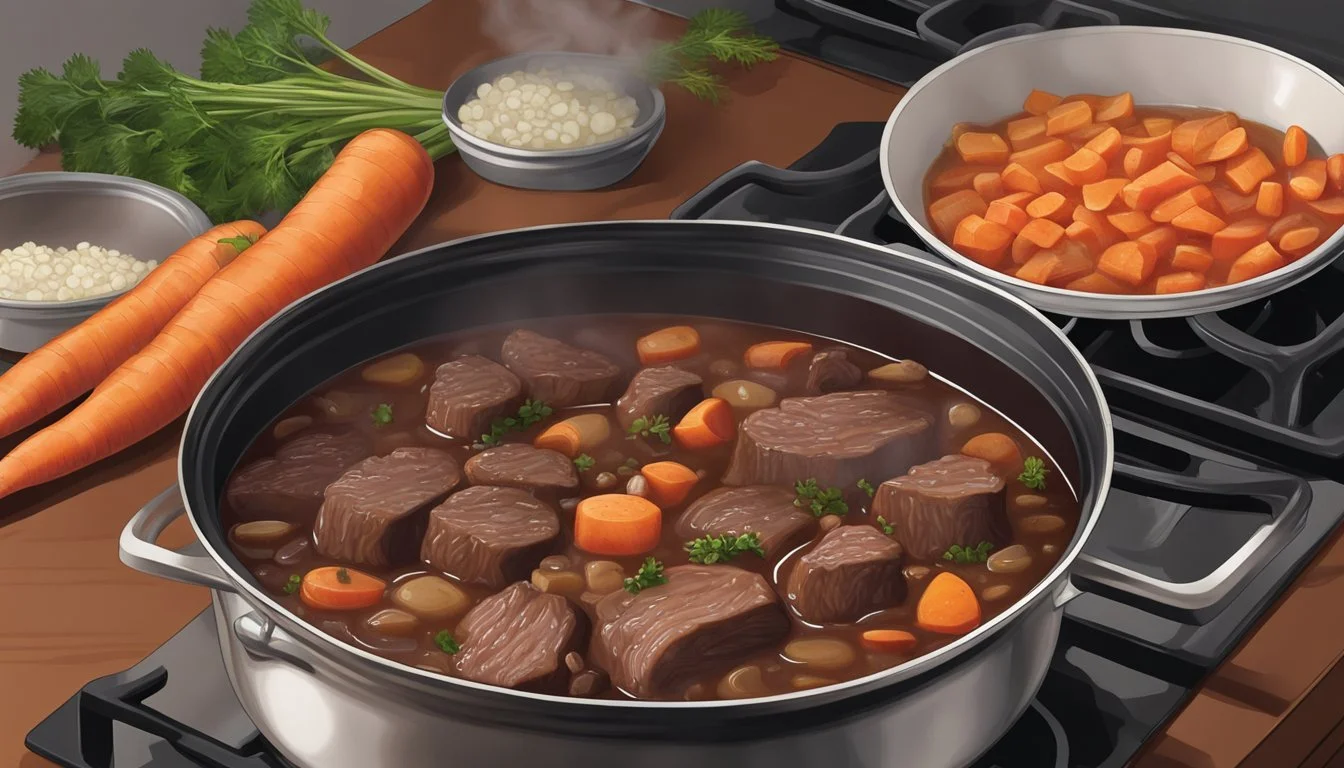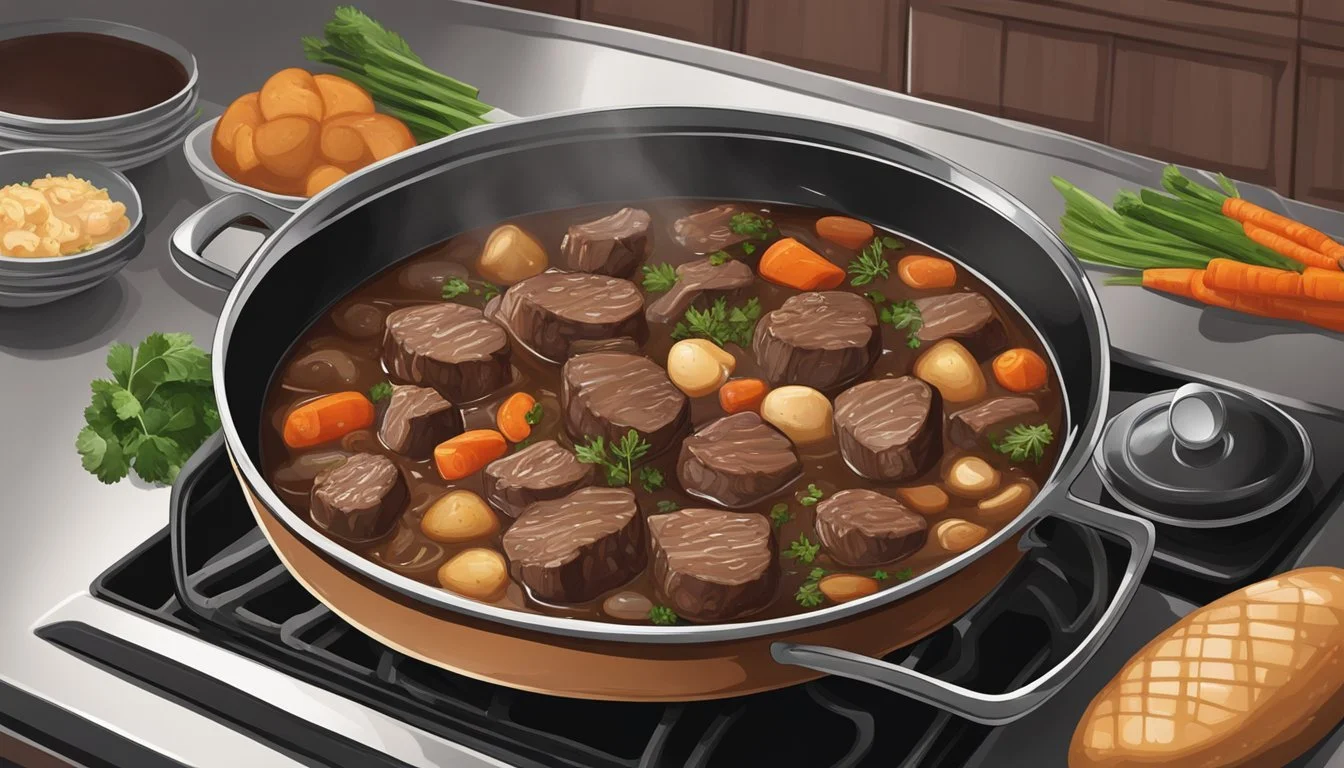Best Way to Reheat Beef Bourguignon Without Losing Flavor
Expert Tips for Richness Retention
Beef (What wine goes well with beef?) Bourguignon, a classic French dish renowned for its rich flavors and tender meat, is a quintessential comfort food. This hearty stew, steeped in culinary tradition, blends the robustness of beef, the earthy essence of mushrooms, and the depth of red wine to create a symphony of taste. Whether enjoyed freshly cooked or as a leftover, the dish's complexity intensifies, imbuing the flavors as they meld together over time. However, the challenge often lies in reheating Beef Bourguignon (What wine goes well with beef bourguignon?) without losing its savory richness that makes it so beloved.
The key to preserving the integrity of Beef Bourguignon is in the reheating technique. Gently warming each component secures the savory profile and tender texture of the meat, without compromising the integrity of the vegetables and the velvety sauce. Whether employing the steady warmth of an oven, the delicate control of a stovetop, or the swift convenience of a microwave, each method offers advantages that can maintain, if not enhance, the dish's flavorful character. Thoughtful reheating guarantees that the Beef Bourguignon will be savored in its best form, retaining the comfort it promises in every bite.
Understanding Beef Bourguignon
Beef Bourguignon is a classical French dish known for its deep flavors and rich history. Preserving its essence during reheating is vital to maintaining the integrity of its taste and consistency.
History of the Dish
Beef bourguignon finds its roots in the Burgundy region of France, a dish that evolved from a traditional peasant meal to a refined staple of French cuisine. Its popularity surged due to its association with famed chef Julia Child, making it well-known across the world.
Key Ingredients and Flavors
The dish is centered on beef, slow-cooked to perfection in red wine—usually from Burgundy—with bacon adding a smoky depth. Essential vegetables include carrots, mushrooms, and pearl onions, while tomato paste, all-purpose flour, and a bouquet of herbs round out the flavor profile. Each ingredient plays a crucial role in creating the dish's signature rich sauce and succulent texture.
Mushrooms
Pearl onions
Sauce Components:
Red wine
Bacon
Tomato paste
All-purpose flour
Herbs (typically thyme, bay leaf)
Importance of Preservation for Reheating
To ensure the dish's complexity and layers of flavor remain intact when reheating, one must carefully manage the temperature and method of warming. Avoiding high heat preserves the tenderness of the beef and the structure of the vegetables. Utilizing a gentle heat source, such as an oven or stovetop, at a moderate temperature is key to maintaining the dish's integrity.
Pre-Reheating Preparation
Proper pre-reheating preparation is essential for beef bourguignon to ensure the dish's flavors and textures are preserved. The preparation stage involves two key processes: thawing if the dish is frozen and bringing it to room temperature before reheating. By following these steps, one can help maintain the quality of the beef bourguignon.
Thawing Procedures
If the beef bourguignon has been stored in the freezer, it should be transferred to the refrigerator to thaw gradually. Thawing in the refrigerator can take several hours, up to 24 hours for a larger quantity, so planning ahead is crucial. The table below outlines an approximate thawing timetable based on the weight of the beef bourguignon:
Weight Thawing Time in Refrigerator 1 lb 5-6 hours 2 lbs 10-12 hours 3 lbs 15-18 hours 4 lbs 20-24 hours
It's important to ensure the beef bourguignon is in a covered container to prevent any cross-contamination and to maintain its quality.
Bringing to Room Temperature
Before reheating, it's beneficial to let the thawed beef bourguignon sit out of the refrigerator to come to room temperature. This allows for more even heating and helps maintain the integrity of the beef and sauce. Leaving the beef bourguignon out for approximately 30 minutes should be sufficient. However, one should never leave the dish out for more than two hours for food safety reasons.
By carefully thawing your beef bourguignon in the refrigerator and allowing it to come to room temperature, you set the stage for a successfully reheated dish that retains its richness and flavor.
Reheating Beef Bourguignon
Reheating Beef Bourguignon requires attention to maintain its flavor and texture. The right technique ensures the dish is evenly heated while preserving its moisture and richness.
Stovetop Reheating Method
One can reheat Beef Bourguignon on the stove by placing it in a pot or Dutch oven. It's crucial to heat it over a low flame to avoid burning, and stir occasionally to promote even heating. If necessary, one might add a little bit of water or stock to keep it moist.
Oven Reheating Techniques
Oven reheating is optimal for retaining the meat's tenderness. Preheat the oven to a moderate temperature of around 350°F (180°C). Place the Beef Bourguignon in an oven-safe dish, and cover with a lid or aluminum foil. Heat for 25-50 minutes, depending on the portion size, checking to prevent overcooking.
Microwave Reheating Tips
For a quicker option, the microwave can be used, though it might not yield the same level of evenness. Place the stew in a microwave-safe dish, cover loosely and heat in one or two-minute increments, stirring in between to ensure even reheating. Monitor closely to prevent the sauce from drying out.
Slow Cooker Reheating Option
A slow cooker offers a gentler approach that can slowly bring the beef bourguignon back to temperature without drying it out. Reheat on a low setting to keep the ingredients from overcooking and to allow flavors to blend well. This method might take a few hours but can yield very tender and flavorful results.
Maintaining Quality and Texture
When reheating beef bourguignon, preserving its richness hinges on proper technique. The aim is to maintain the tender texture of the meat and the deep, developed flavors while ensuring the sauce retains its desired consistency.
Avoiding Overcooking
To prevent the beef from becoming tough and losing its tender quality, it is crucial to reheat the dish slowly and at a moderate temperature. Oven reheating is typically recommended at a temperature of 325°F (163°C). The beef should be monitored closely and removed from the heat once it has reached the appropriate serving temperature, thus preventing any further cooking that could deteriorate its texture.
Preserving Moisture and Sauce Consistency
The key to maintaining moisture and achieving the right sauce consistency lies in two important steps:
Covering: Using aluminum foil to cover the dish helps trap steam, which in turn preserves the moisture of the meat and prevents the sauce from drying out.
Stirring: Stirring the beef bourguignon occasionally as it reheats helps to evenly distribute heat and can aid in maintaining the sauce's rich and even consistency. This ensures that the flavors remain well-balanced throughout the dish.
Ensuring Even Heating and Flavor Distribution
Even heating is crucial for preserving the integrity of the beef bourguignon's flavors. If using a microwave:
It is recommended to select a moderate power setting and to stir the dish periodically.
For oven reheating:
The dish should be placed in the center of the oven to allow for uniform heating.
The beef bourguignon should be allowed to warm up gently to allow the flavors to further develop and deepen, without risk of the ingredients separating or becoming overcooked.
Safety and Storage Considerations
Proper handling and storage are crucial to maintain the safety and quality of beef bourguignon when storing leftovers. Each stage, from cooling to refrigeration, plays a role in preventing bacterial growth.
Proper Cooling and Storage
After enjoying a meal, leftovers should be cooled promptly before storage. Beef bourguignon must not be left out at room temperature for more than two hours. To expedite cooling, one can divide the stew into smaller portions or shallow containers, allowing for quicker temperature reduction.
Refrigeration and Freezer Guidelines
Once cooled, beef bourguignon should be transferred to an airtight container. It can then be stored in the fridge for 3-4 days or in the freezer for up to 3 months. For optimal freshness, it's recommended to wrap the container with plastic wrap or aluminum foil before refrigerating or freezing it.
Refrigerator (at or below 40°F)
Storage time: 3-4 days
Freezer (0°F or lower)
Storage time: Up to 3 months
Avoiding Bacterial Growth
To inhibit bacterial proliferation, one must ensure that the beef bourguignon is reheated to an internal temperature of 165°F as measured with a food thermometer. Any longer refrigeration or improper reheating may increase the risk of foodborne illnesses due to bacteria.
Enhancing the Reheated Dish
When reheating Beef Bourguignon, the focus should be on preserving and enhancing the dish's richness and depth of flavor. Careful adjustments to seasoning and thoughtful serving suggestions can elevate the reheated dish to its pinnacle of taste and presentation.
Additional Seasoning Adjustments
As Beef Bourguignon is a robust dish, its flavors can develop and change when refrigerated. Upon reheating, it may require a few minor but precise seasoning adjustments. One should start by tasting the dish once it's heated through. If the flavors seem muted, a pinch of salt can help to bring out the other flavors. However, be judicious with salt as it is easy to over-season.
Enhancing the dish with fresh herbs (how long do fresh herbs last?) or a bit of garlic can also revive the flavors. For example, adding a minced garlic clove during the last few minutes of reheating can impart a fresh, aromatic kick that complements the existing flavors.
Serving Suggestions
The right side dishes and presentation are key to serving reheated Beef Bourguignon. Serve the dish steaming hot to ensure the flavors are at their best. Mashed potatoes offer a classic pairing: their creamy texture and neutral taste provide a perfect backdrop that helps the bold flavors of the Bourguignon stand out.
Suggested Side Description Mashed Potatoes A smooth, buttery base that absorbs sauce Green Beans A crisp contrast to the tender beef Bread To sop up the rich sauce
Plating the Beef Bourguignon on top of a mound of mashed potatoes not only looks appetizing but also ensures that none of the sauce goes to waste.
Common Reheating Challenges and Solutions
When reheating Beef Bourguignon, the challenges often lie in preserving the texture, preventing ingredient separation, and maintaining the balance of flavors. Addressing these issues effectively ensures the dish remains as delightful as when it was first cooked.
Dealing with Texture Changes
The tender texture of the meat and the softness of the vegetables in Beef Bourguignon can become compromised when reheated improperly. Solution: It is recommended to reheat gently in an oven on a low to medium heat, around 225-250 degrees Fahrenheit, which allows for gradual warming. Cover the dish with aluminum foil to lock in moisture, and avoid high heat that can toughen the beef.
Managing Separation of Ingredients
The rich sauce in Beef Bourguignon may separate or the fat may rise to the top during reheating. Solution: Stirring the contents periodically when reheating on the stovetop over medium heat helps maintain an even consistency. Additionally, one can reintegrate the fat into the sauce by whisking, ensuring the sauce retains its thickness and richness.
Correcting Flavor Imbalances
A change in flavor can occur after storing and reheating Beef Bourguignon. Solution: After reheating, taste the dish and adjust the seasoning if needed. Sometimes, the dish may require a touch more of salt or pepper to revive its original flavor profile, or a small amount of fresh herbs to enhance the richness and mitigate any difference in taste that may have arisen from reheating.






